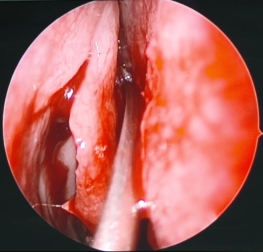Neuroendoscopy is a minimally-invasive surgical procedure in which the neurosurgeon operates through small holes (of a few millimeter diameter) in the skull or through the mouth or nose. Neuroendoscopy enables neurosurgeons to:
Neuroendoscopy utilizes small, flexible, lighted tubes called endoscopes to visualize various parts of the brain, skull base, or spinal cord through small openings. Endoscopes serve as small microscopes, magnifying critical anatomical structures so the surgeon can easily see the various diseased areas requiring repair, removal, or replacement. The surgery is performed while looking at a monitor which displays magnified real-time video from the endoscope. The rest of the surgery is done with the similar techniques as to open surgery, but requires the use of special instruments and allows for less retraction and chance of injury to the brain.
Because the use of endoscopes is much less intrusive into these anatomical structures than is conventional surgery, endoscopic neurosurgery is referred to as minimally invasive neurosurgery. For example, endoscopic neurosurgery in general does not require large incisions on the scalp or skull, or extensive dissection through brain tissue. The result is a faster and simpler procedure with greatly reduced post-operative complications, faster recovery, and less pain and scarring. The actual removal or repair of the problem is done as effectively, safely, and completely as with conventional “open” surgery.

In intracranial surgery, endoscopes are introduced into the brain through very small skull openings, following which tiny instruments may be placed through the same opening for the purpose of performing endoscopic tumor biopsy, colloid cyst resection, and endoscopic cyst fenestration, as well as to treat hydrocephalus. Operations can last from about 15 minutes to an hour, and patients are typically discharged the next day from the hospital.
Endonasal (through the nose) neurosurgery is frequently performed to treat a range of conditions, included among which are pituitary tumors, meningiomas and chordomas. The surgeon is able to maneuver the endoscope to different areas, which allows treatment of brain tumors in different locations. The surgeon can also direct the endoscope downward and clearly see the palate and the back of the throat to operate on the top of the spine and base of the skull. Patients are typically discharged between two and four days after surgery, depending on size of the tumor and overall functioning.
While each patient’s medical history, age, condition and other factors play a role in the outcome of endoscopic brain surgery, here are some of common benefits associated with the procedure:
